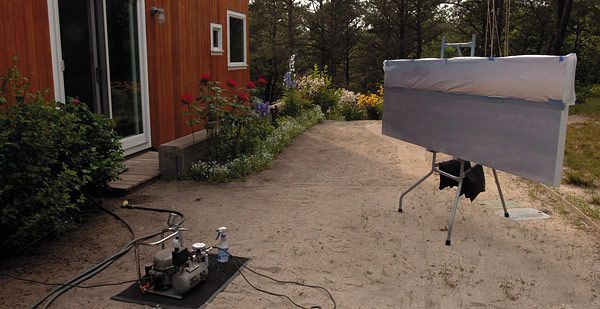漆水和天空与乔恩·r·弗里德曼

一个干净的扫描:
在开始之前低潮,日出,我决定图像的本质应该是一个瞬时,全景扫描。“我希望这幅画打观众的眼睛和一个元素即时性,首先呈现一个发光的三位一体的空气,大地,水,然后释放观众流连忘返的语气和纹理细节。“
五步演示

1。组成示意图
启动我的画布后与丙烯酸石膏,我画我的作文与稀释丙烯酸洗。蚕食了图像与刷不会给我快速的感觉,戏剧性,整体颜色和弦我想要的,所以我决定用我的岩田喷枪。用胶带和塑料布,我介绍了沙滩和水,然后洒在天空颜色金色液体开始与丙烯酸。在这张照片塑料已经被推开,显示第一个程序的颜色。在继续讨论之前,我remasked和继续喷,直到我完全满意的天空。

2。基本着色
接下来我笼罩了天空,基本的淡蓝灰色喷洒水的颜色在较低的帆布。我的工作室没有良好的排气系统,所以我工作的初始阶段的帆布外。

3。固定架纸
里面移动,我把帆布平放在桌面,坚持准备固定架纸(防水描图纸与粘合底布)这幅画的表面。接下来的几天,我把这些潮汐池和小河形状从纸与固定架把刀,刀旋转360度,减少复杂的形状。透明的固定架纸让我看到我的丙烯酸素描下面,但因为这幅图,我正在画粗和作曲我切。
当我完成切割,我推开周围的固定架,然后喷池和溪谷暴露与黑暗海滩地区,灰色棕色。在这张照片中,喷涂完成后,胶带、塑料和固定架纸面具被删除。基本的和弦色系和根本分歧的成分已经到位。

4。混合
我使用油和各种各样的刷子的云,感觉“肉”和触觉比喷漆的天空。加强右下的天空,我混我的颜色与Grumbacher绘画媒介和混合醇酸到喷漆的天空,使用各种软,扇形的刷子。对于微妙的繁文缛节纷纷映入眼帘,潮雕刻表面的海滩,我拖放到画布上施压油漆用硅胶将色彩塑造者(皇家主权)。这些让我创建精确的边缘,其中一个对另一个颜色,还顶撞涂片颜色一起无缝所以海滩似乎受到冲浪而不是从计算笔刷组装。

5。收尾工作
拖动和混合颜料在画布上建的水平几乎是一个体育活动,和工作性的油漆时刻改变的时刻,导致一种妥协摔跤比赛。大约半个小时后,油漆太干继续操作。最后外观的海滩是许多组合层的结果,导致一个密集的、巧妙的有条纹的不透明度,站在天空形成鲜明对比的透明光度。
原来我已经包括小型的图的一个渔夫去左边,就像一个视觉纤维加入海滩、水和天空。最后,我消除了图,因为它太视觉磁铁,防止眼睛从自由沿着海滩漫步在低潮,日出(丙烯酸和石油,30×96)。
原文如下:
Paint Water and Sky with Jon R. Friedman
One Clean Sweep:
Before beginning Low Tide, Sunrise, I decided that the essence of the image should be an instantaneous, panoramic sweep. “I wanted the painting to smack the viewer’s eye with an elemental immediacy, first presenting a luminous triad of air, earth, and water — and then releasing the viewer to linger over details of tone and texture. ”
Five-Step Demo
1. Composition Sketch
After priming my canvas with acrylic gesso, I sketched my composition with a diluted acrylic wash. Nibbling away at the image with brushes wouldn’t give me the fast feeling of dramatic, holistic color chords I wanted, so I decided to use my Iwata spray gun. With masking tape and plastic sheeting, I covered the beach and water and then sprayed on the intial sky color with Golden liquid acrylic. In this photo the plastic has been pulled away, showing the first application of color. Before moving on, I remasked and continued spraying until I was fully satisfied with the sky.
2. Basic Coloring
Next I covered the sky and sprayed the basic light blue-gray color of the water over the lower canvas. My studio doesn’t have a good exhaust system so I worked on the initial stages of the canvas outside.
3. Frisket Paper
Moving inside, I laid the canvas flat on a tabletop and adhered prepared frisket paper (waterproof tracing paper with an adhesive backing) to the painting’s surface. Over the next few days, I cut the tidal-pool and runnel shapes from the paper with a frisket knife—which has a blade that rotates 360 degrees for cutting intricate shapes. The transparent frisket paper allowed me to see my acrylic sketch underneath, but because this sketch was rough, I was drawing and composing as I cut.
When I finished cutting, I pulled away the frisket surrounding the pools and runnels and then sprayed the exposed beach areas with dark, gray-browns. In this photo, the spraying is finished, and the tape, plastic and frisket-paper mask are removed. The basic color chords and the fundamental divisions of the composition are in place.
4. Blending
I used oils and a variety of brushes for the clouds, which feel “meaty” and tactile compared to the spray-painted sky. To intensify the lower right of the sky, I mixed my colors with Grumbacher Alkyd painting medium and blended them into the spray-painted sky, using a variety of soft, fan-shaped brushes. For the subtle tonalities and tide-carved surface of the beach, I dragged and pressured paint onto the canvas with silicone-tipped Colour Shapers (Royal Sovereign). These let me create precise edges, where one color butts against another, and also smear colors together seamlessly—so the beach appears shaped by the surf rather than assembled from calculated brushstrokes.
5. Finishing Touches
Dragging and blending paint across an 8-foot horizontal canvas is an almost athletic activity, and the workability of the paint changes from moment to moment, resulting in a kind of give-and-take wrestling match. After about an hour, the paint is too dry to continue manipulating. The final appearance of the beach is the result of many built-up layers, leading to a dense, subtly striated opacity that stands in marked contrast to the sky’s transparent luminosity.
Originally I had included the diminutive figure of a fisherman off to the left, like a visual staple joining beach, water and sky. In the end, I eliminated the figure because it was too much of a visual magnet, preventing the eye from roaming freely along the beach in Low Tide, Sunrise (acrylic and oil, 30×96).








